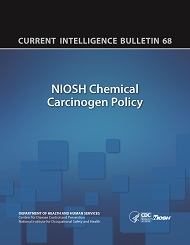NIOSH Chemical Carcinogen Policy
July 2017
DHHS (NIOSH) Publication Number 2017-100

Occupational exposure to chemical carcinogens still presents risks to many in the workforce. The burden from exposure to occupational carcinogens on workers, their families, employers, and the nation is difficult to measure. Cases are missed and go unreported because of the length of time, often decades, between exposure to a carcinogen and resultant cancer and because cancers can also have non-occupational causes, making it difficult to determine causation in individual cases. To aid in the prevention of occupational cancer, the National Institute for Occupational Safety and Health (NIOSH) develops guidance to protect workers from adverse effects of occupational carcinogens. This effort has spanned more than 40 years. In this current document, the policy by which NIOSH classifies chemicals as carcinogens, identifies control levels, and addresses analytical feasibility is being updated because of advances in science and with the intent of providing transparent guidance on how NIOSH assesses and addresses cancer risks.
In July 2017 this document was revised to clarify NIOSH methods related to carcinogenicity at low exposures and to affirm that the OSHA analytical methods are acceptable to determine if the candidate RML-CA is analytically feasible. No substantive changes were made to the policies in this revision.
